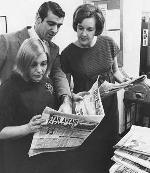Main site navigation
Lillian Roxon

More information about Lillian Roxon can be found in the AWAP register.
Journalist, foreign correspondent and rock music expert Lillian Roxon enjoyed a long and varied career before her untimely death in New York at the age of 41. She was the first full-time female employee at the Sydney Morning Herald's New York office, and her Rock Encyclopedia was published in 1969.
Lillian Roxon was born Liliana Ropschitz in 1932, the daughter of Polish Jewish parents Izydor and Rosa. She spent her early childhood in Alassio on the Italian Riviera before emigrating with her parents and her brothers, Emanuele and Jacob, in 1940. They settled in Brisbane, where Izydor began work as a doctor. In November 1940, the family changed their name by deed poll to Roxon (though Izydor later changed again to Roxon-Ropschitz). They became known as Isadore, Rose, Milo, Lillian and Jack.
Lillian was strongly influenced by the influx of American popular culture in wartime Brisbane, particularly after troops arrived with General MacArthur in 1942. At school she demonstrated obvious intelligence and was a great story-teller, but she was rebellious and she aimed to shock. In 1944, aged twelve, she was sent to St Hilda's School at Southport, an Anglican boarding school for girls. The discipline did not find its mark with Lillian, and she completed her secondary schooling at Brisbane State High School. As a teenager, she socialized with members of the Miya Studio and the Barjai group in Brisbane, and kept up a friendship with Barbara Blackman.
Roxon matriculated in 1948, and the following year she enrolled for a Bachelor of Arts at the University of Sydney. Almost inevitably, she became involved with the Sydney 'Push', a 'self-styled group of socially, intellectually and sexually adventurous young people' who followed the philosophies of John Anderson, and of the Freethought Society co-founded by him. Essentially this meant questioning authority, particularly the authority of church and state. Lillian spent many formative hours with artists, actors, journalists, students, musicians, poets and fellow Push members at the Push hang-out, the Lincoln Inn Coffee Lounge. As an undergraduate, she contributed to the University's student newspaper, Honi Soit, including a regular gossip column called 'Postman's Knock'. She took five years to complete her degree, graduating in 1955 with majors in English and Philosophy.
In 1956, Roxon's father passed away, and she spent eight months in New York. From January 1957, to the chagrin of her mother, she was writing for Weekend, Frank Packer's weekly tabloid magazine in Sydney. Roxon became chief reporter and section editor under Donald Horne. Soon afterward she returned to the United States, where she was employed at the New York bureau of the Sydney Daily Mirror. A short stint in London saw her writing for the Sydney Morning Herald's Fleet Street bureau, but Roxon returned once again to New York as a freelance journalist. Her weekly column appeared in the women's pages of the Sydney Sun from 1962. She also wrote for the Sun-Herald and the TV Times, and became the first female full-time employee at the New York office of the Sydney Morning Herald. Roxon wrote for the Herald until the end of her life. On occasion, feature articles for Woman's Day brought her into contact with the big names of the era. One assignment saw her on the set of Night of the Iguana in Mexico with director John Huston and actors Richard Burton, Ava Gardner and Deborah Kerr. Elizabeth Taylor was also on set, and Roxon mixed with them all.
Evidently, Lillian Roxon was not phased by big names. By the 1960s, she was indulging a deep fascination with the new, fast and loud world of rock music and becoming well acquainted with the major rock musicians of the period. Her strong friendship with rock photographer Linda Eastman ended only with Linda's marriage to Paul McCartney. Roxon was renowned for her journalism, but perhaps found greater fame with her commentary on rock music, though the two often combined. In 1969 she published her now famous Rock Encyclopedia. It was, boasted its cover, 'the most ambitious book ever written on rock and its roots, an innovative treatment of the generation's heroes - the poets and minstrels of our time'. The encyclopedia listed rock groups, their members and their instruments, and contained biographical information, discographies and statistical analysis. It covered everyone from Chuck Berry to James Brown, Jimi Hendrix, Janis Joplin, Bo Diddley and the Beatles, and was written with Roxon's trademark wit. The book was republished in 1971, and again by Eddie Naha in 1980. In her author's note, Roxon explained that 'trying to get the rock world to keep still long enough for me to take its picture was one of the most difficult tasks in putting this book together. Groups split even as I wrote of their inner harmony, and got themselves together just as I had acknowledged their tragic demise. Baritones turned sopranos overnight; bands expanded and contracted their personnel like concertinas... but then, isn't this restlessness exactly what rock is all about?' In the end, said Roxon, 'the music itself has to tell the story. This book is the companion to that story'.
By the early 1970s she had a regular column, 'The Top of Pop', with New York's Sunday News, and another, 'The Intelligent Woman's Guide to Sex' in Mademoiselle magazine. Roxon had well and truly carved her own niche. Toward the end of her life, says biographer Robert Milliken, she 'had an influential platform in New York as a popular feminist as well as a rock expert'. Roxon never married. Troubled by asthma throughout her life, she was finally overcome by the illness and died in her New York home on 10 August 1973, aged 41.
Image
Image reproduced courtesy of the Sydney Morning Herald